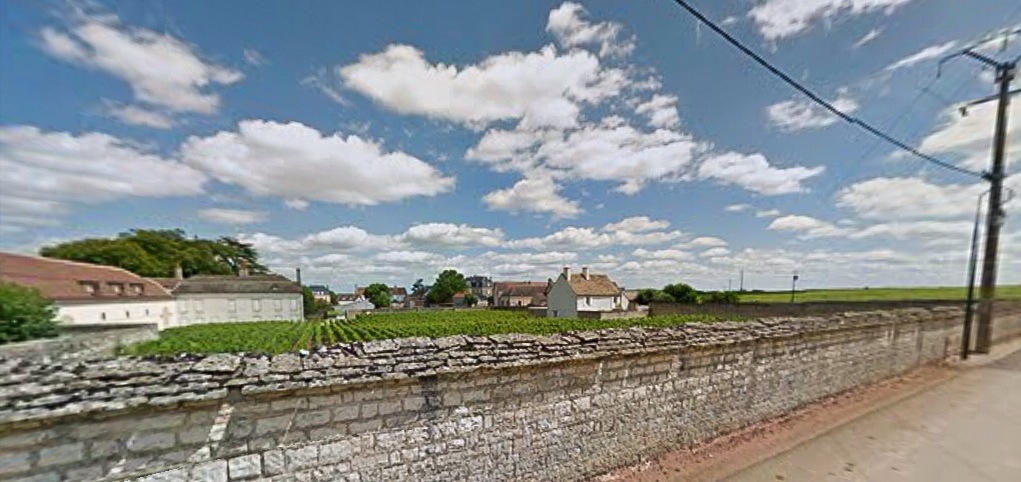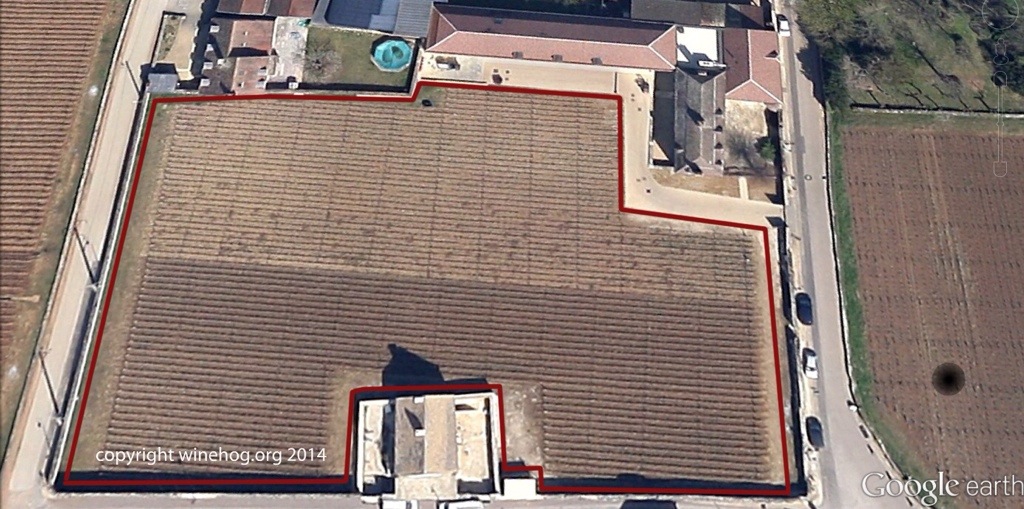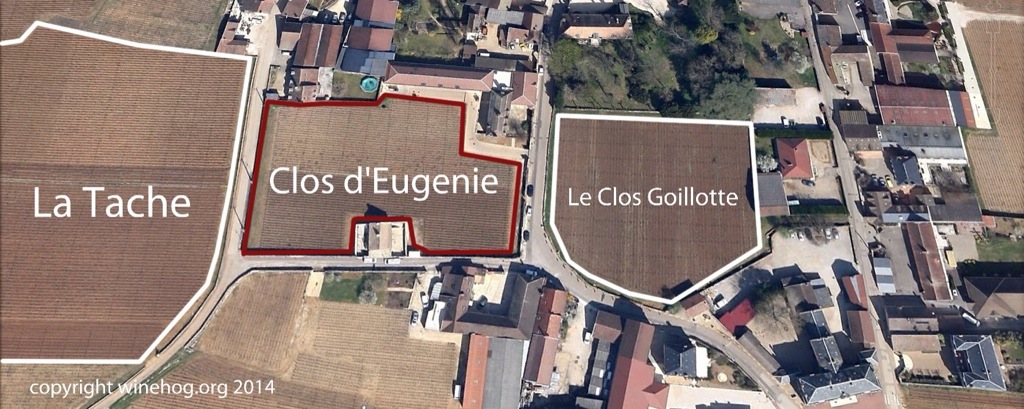One of the new vineyard names in Burgundy is Vosne-Romanee Clos d’Eugenie – a small village monopole clos located just below La Tache and squeezed in between La Tache and Le Clos Goillotte.
The vineyard has an interesting history … and was for many years known as Clos Frantin. We have to go back to the French revolution to find the beginning of the Frantin era in Burgundy wines.

Photo: Clos d’Eugenie seen from rue de la Tache.
From Legrand to Frantin
Antione-Vincent Legrand (1759 – 1849) was a field marchall in Napoleon I army, an he acquired some vineyards after the French revolution. His wife Marie Antoinette Mollerat came from a wealthy family in Nuits-Saint-Georges and she also brought some family vineyards into the marriage. He established a domaine in Vosne-Romanee with vineyards in some of more prominent terroirs in the region.
The daughter Louise-Ester Legrand (1791 – ) married Jean-Edme Frantin (1780 – 1863) in 1819, and this was how the name Frantin really entered the Burgundian wine history.
Jean-Edme Frantin came from a family in Dijon, where his father Louis Nicolas Frantin was publishing and printing books – among others he worked with Claude Courtépée on Description générale et particulière du Duché de Bourgogne vol 2 (1774).
At some point before 1855 the Legrand estate was renamed to Frantin, and the quite impressive holdings in Vosne-Romanee was transfered to Jean-Edme Frantin and his wife. The early history is somewhat unclear, but as always Lavalle 1855 is a fixpoint.
Frantin owned the following vineyards in 1855 – according to Lavalle.
- Les Richebourg
- Les Varoilles sous Richebourg – 3 ha 6 ares
- Les Beaux-Monts
- Les Beaux-Monts Bas
Frantin also owned the estate 14 Rue de la Goillotte and the small clos just south of the estate – the vineyard later known as Clos Frantin and since 2011 as Clos d’Eugenie.
At this point Frantin owned all of Les Varoilles sous Richebourg – a part of the current Richebourg – and even some holdings inside the original Richebourg vineyard – Les Richebourg.
The Frantin couple had at least one daughter, but when Jean-Edme Frantin passed away in 1863 – the domaine was sold off – at least partly to the Chanut family – a large and expanding domaine in Vosne-Romanee.
The Chanut ownership of the Frantin estate
In 1863 Philibert Eugene Chanut bought Maison Frantin – 14 Rue de la Goillotte in Vosne Romanee – from the widow of Jean-Edme Frantin. The price of the Frantin etate was 40.000 F, and included the estate buildings, the garden and a vineyard south of the estate with a area of 47,2 ares7 – most likely the Clos Frantin vineyard – recently renamed to Clos d’Eugenie – see map below.
The Frantin estate is the neighbour of La Goillotte – the old main building of the Chanut estate and the vineyard today known as Le Clos Goillotte. Chanut thus owned both these village clos located inside Vosne-Romanee – see map below.
In 1885 Philibert Eugene Chanut passed away, and the estate was split between the two heirs over the next years. The Maison Frantin at 14 rue Goillotte was still a part of the Chanut estate when Philibert Chanut died.
After the death of Philibert Eugene Chanut the Frantin estate was passed on to Jules Edouard Chanut – it’s however unclear when Frantin was sold, but it’s likely it happened between 1905 – 1909 where Jules Edouard Chanut sold off all his properties.
At this stage I have no information about who acquired the vineyards from the Jules Edouard Chanut estate, but the Frantin estate – 14 Rue de la Goillotte and some of the vineyard including the small clos south of the estate buildings ended up under Grivelet ownership – either directly or via another owner.
The Grivelet ownership
The Grivelet family from Chambolle-Musigny is the next – known – owner of the Frantin estate. In 1920 Rodier mention Grivelet-Modot as a owner of Les Verroilles ou Richeborg, and during the next decades there are further documentations of the Grivelet ownership.
The Grivelet family were originally barrel makers, and the son Fernand Alfred Grivelet (1885 – 1958) was running a domaine in Chambolle-Musigny. Grivelet was married to Marie Camille Francoise Pauline Modot, and they had a son Bernard Grivelet in 1913.
Grivelet was one of the more controversial producers in Burgundy, and the history of the estate is quite unclear. The domaine was located in Chambolle-Musigny in the building currently used by Hotel Ziltner.
The Clos Frantin brand was under the Grivelet ownership used for a Vosne-Romanee village cuvee from the vineyard Clos Frantin – located just south of the estate – and just below La Tache/Les Gaudichot ou La Tache.
After some turbulent years and the death of Fernand Alfred Grivelet, the domaine was sold of to Maison Albert Bichot. The deal included the vineyards and the estate buildings on 14 Rue de la Goillotte in Vosne Romanee.
Domaine du Clos Frantin – owned by Bichot
Maison Albert Bichot took over the Grivelet estate and the Frantin brand in 1964, and the Domaine du Clos Frantin now includes all the top vineyards owned by Albert Bichot in Cote de Nuits.
The top wine is still the Richebourg made from a 0.07 ha plot located at the very top of Les Varoilles ou Richebourg. They also makes Le Chambertin, Grands Echezeaux, Echezeaux, Clos de Vougeot a lovely Vosne Romanee Les Malconsort and a Vosne village + a few other wines.
Bichot kept the Frantin estate and the village vineyard Vosne-Romanee Clos Frantin until 2008, where the estate buildings, the garden and the Clos Frantin vineyard was sold to Domaine d’Eugenie.
The Frantin brand is however maintained at Albert Bichot who continue to sell the top end Domaine wines from Cote de Nuits under the Frantin name – Domaine du Clos Frantin.
Vosne Romanee Clos Frantin becomes Clos d’Eugenie
Domaine d’Eugenie was created by Francois Pinault in 2006, where he acquired the Rene Engel vineyards. Pinault, who also own Chateau Latour in Bordeaux, wanted to create a top Burgundy domaine, and the vineyards from Rene Engel was a good start. The Domaine is named after the grandmother of Francois Pinault.
Pinault was however in need of a estate where he could make the wine, and after producing the wines in a rented facility in Nuits-Saint-Georges he acquired the Frantin estate from Bichot. The village vineyard Clos Frantin was included in the deal, and in 2011 this vineyard was officially renamed to Clos d’Eugenie when the 2009 vintage was released from Domaine d’Eugenie.
Pinault has invested a lot in the Frantin estate, and the buildings have been renovated to the highest standards, and a new chai has been build behind the estate buildings – see photo below.

Photo: Clos d’Eugenie with the estate in the upper right corner – the long building is the new Chai
The wines from Clos Frantin/Clos d’Eugenie
Grivelet produced a Vosne-Romanee Village called Clos Frantin, and it is likely that this cuvee came at least partly from the Clos Frantin vineyard – one never know with the Grivelet wines!. The oldest vintage I have seen of the Grivelet Vosne-Romanee Clos Frantin is 1934 and the latest vintage is 1962.
When Bichot acquired the Clos Frantin domaine from Grivelet it was the end of the Clos Frantin cuvee. The wine from the Clos Frantin vineyard was blended with the wine from the other holdings of Vosne-Romanee village – mainly Les Communes and Damaudes.
In 2009 d’Eugenie moved into the new winemaking facility at 14 rue Goillotte and they decided to make a separate cuvee from the small clos just south of the domaine. The cuvee was named Clos d’Eugenie and at the same time the vineyard changed name from Clos Frantin to Clos d’Eugenie.
D’Eugenie have produced the Vosne-Romanee Clos d’Eugenie in earch vintage since 2009. The production is estimated to around 1000 – 2000 bottles depending on the vintage – d’Eugenie mention the area of the vineyard is now 0.57 ha.
References & Sources:
- Jules Lavalle, Histoire et Statistique de la Vignes et Des Grands Vins de la Côte d’Or (1855)
- M.R. Danguy et M. Ch. Aubertin, Les Grands Vins de Bourgogne (1892)
- Camille Rodier, Le Vin de Bourgogne (1920)
- Gert Crum, Domaine de la Romanee-Conti (2012)
- Allen D. Meadows, The Pearl of the Côte (2010)
- Association de l’Abbeye de Saint-Vivant, Saint-Vivant de Vergy (2010)
- Liquidation de la communauté M&Mme Chanut et de la succession du Dr Eugène Chanut du 8 mai 1889
Special thanks to to the Gaudemet family for a lot of hard work getting the information processed and made available to me – my sincere gratitude goes to Laure Gaudemet, Pierre Gaudemet and Louis Marie Gaudemet.


 - A true vin d’émotion – a Burgundy of passion
- A true vin d’émotion – a Burgundy of passion - A truly hedonistic wine – lively and enjoyable
- A truly hedonistic wine – lively and enjoyable - A vivacious wine for pure indulgance
- A vivacious wine for pure indulgance - A Vin Vif - fresh, energetic and with a light appearance
- A Vin Vif - fresh, energetic and with a light appearance